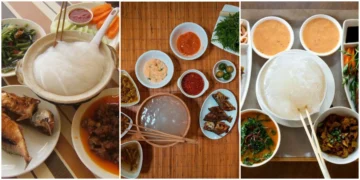Cameroon, known for its vibrant culture, vibrant music, and colorful festivals–is home to a rich culinary legacy that mirrors its diverse identity. Ndole stands out as the best food of Cameroon. This Cameroonian cuisine is an irreplaceable national treasure; this sumptuous stew perfectly balances bitterness with savory depth to become one of its signature dishes and an icon of tradition, community, and resilience.
What makes Ndole the Best food of Cameroon?
Ndole has earned its place among Cameroon’s premier dishes thanks to its intricate yet balanced flavors. Ndole stands out as an irresistibly tasty meal when enjoyed communally on festive occasions: its signature bitterness can be balanced out with creamy ground peanuts for a creamy richness that perfectly balances out its bitter leaves, while meat or seafood adds layers of robust savoriness. More than just food, Ndole is an expression of Cameroonian identity and hospitality!
Ndole stands out as an exceptional dish due to its adaptability. Based on regional preferences and seasonal availability, the rich stew can be prepared using any variety of proteins ranging from beef, goat, and chicken to fish and shrimp. Ndole is traditionally served with starchy sides such as rice, boiled plantain, or bobolo (steamed fermented ground plantain wrapped in banana leaves) that provide the ideal canvas for its rich layers of flavors. Ndole brings people together, sparking memories while strengthening social bonds in every bite taken!
Key Ingredients of Ndole

- Bitter Leaves: At the core of Ndole is its use of bitter leaves derived from Vernonia amygdalina plants, prized for their distinct taste. These leaves create the necessary bitterness that helps define this dish; when prepared correctly, however, their bitterness should balance out with other flavors instead of overwhelming your palate.
- Roasted Peanuts (or Peanut Paste): Ground peanuts add luxurious creaminess and an irresistibly nutty flavor that balance the bitterness of the leaves, thickening your sauce for a velvety texture and adding luxuriousness.
- Proteins: Ndole stew is often packed with proteins. Depending on regional and personal tastes, protein sources include beef, goat meat, chicken, or seafood such as fish and shrimp – each adding its own distinctive flair to the stew.
- Aromatics: Onions, garlic, and sometimes tomatoes are sauteed together to form an aromatic base for any dish, adding warmth and depth.
- Spices and Seasonings: Salt, black pepper, and chili (for those who like a bit of spice) can be used to enhance and balance flavor in food, while local spice blends may further intensify taste. Some recipes even use bouillon cubes as additional seasoning agents to add even more zest!
- Vegetable Oil: Essential to sauteing aromatics such as onions and garlic, vegetable oil is used for browning these aromatics quickly to release their flavors and create a tasty base for any stew dish.
Prepare Ndole (Best Food of Cameroon)

- Preparing Bitter Leaves: First, the bitter leaves must be washed thoroughly to rid themselves of any impurities. According to tradition, it is parboiled briefly to reduce its intensity before being rinsed and set aside. This step ensures that their natural bitterness can blend seamlessly with other ingredients without creating an offensive bite.
- Roasting and Grinding Peanuts: Dry roasted peanuts are either ground into a paste or coarsely chopped to meet the desired texture. This peanut paste forms the basis for Ndole’s signature creamy texture. Some chefs prefer making fresh paste while others use pre-made peanut butter as an easy shortcut.
- Sauteing Aromatics: Begin by heating vegetable oil over medium heat in a large, heavy-bottomed pot. Once hot, finely chopped onions and garlic should be added and sauteed until soft and aromatic. In some variations, tomatoes are added at this stage for an additional rich, tart base to enhance other flavors in your recipe.</li>
- Cooking Proteins: Your chosen protein (beef, goat meat, chicken, or seafood) will be seared until all sides have become brown. This step helps seal in its juices and deepen its flavor profile. Once done, set the finished protein aside while continuing the next steps of preparation.
- Final Adjustments and Serving: To prepare Ndole, final adjustments are made by adding salt, pepper, or any additional spices. Traditionally served hot with starchy sides like rice or plantains that help absorb its rich flavors.
What Makes Ndole Stands Out?

From the pack by perfectly blending bitter, savory, and creamy elements into its stew-like consistency. Thanks to peanut paste and slow-cooked meat, it has the ability to transform naturally bitter leaves into delectable stew. It is an extraordinary testament to Cameroonian chefs’ resourcefulness and creativity in harmonizing disparate flavors!
Ndole also epitomizes the spirit of communal dining. Meals in Cameroon are traditionally shared among family and friends. Its traditional preparation also reflects Cameroon’s cultural pride as all ingredients used come directly from local farms or markets.
History of Ndole (Best Food of Cameroon)
Ndole’s roots run deep into Cameroon’s history and agricultural traditions. Before modern conveniences arrived, Cameroonian communities relied on native ingredients like bitter leaves and ground peanuts. Ndole became a versatile dish that accommodated various available proteins–from livestock or local waterways.
Over time, Ndole has gone from a humble peasant dish to an iconic symbol of national pride in Cameroon. This transformation mirrors Cameroon’s historical development – with indigenous heritage mixed in with colonial and postcolonial influences. Today Ndole remains a beloved family favorite that continues to be prepared with care by subsequent generations.
Discover Original Cameroonian Specialities
- Eru: This delicious stew features leafy vegetables (jute leaves), water-based leaves, and various meats paired with fufu or boiled plantains.
- Fufu: Made of boiled cassava or plantains that are then ground into flour to create its starchy consistency. Fufu goes perfectly with rich stews like Ndole or Eru.
- Pepper Soup: An invigorating broth made with fish, chicken, or goat that is known for its therapeutic benefits. mes
- Koki: An Asian-style bean pudding prepared using black-eyed peas with meat in banana leaves to complete its fermentation.
- Achu Soup: This yellow-hued soup features pounded cocoyam (achu) seasoned with spices and palm oil for flavoring.










Discussion about this post